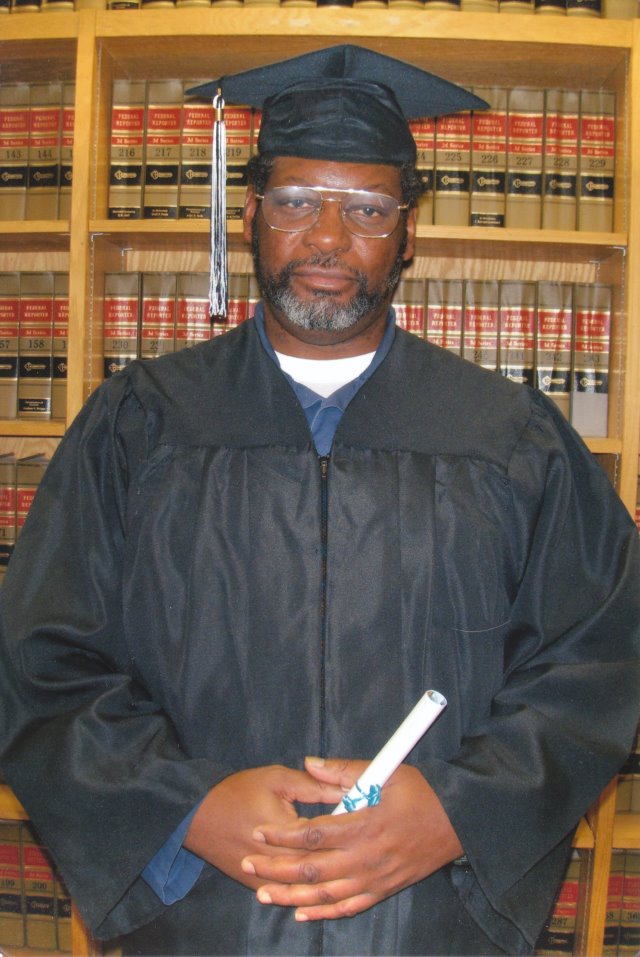
Charles Lewis has been in prison for over 41 years, since the age of 17, framed up for the murder of a Detroit cop he says he did not commit. He has taken college, culinary arts and many other courses, and become a highly skilled jail-house lawyer.
COME TO LEWIS’ POST-CONVICTION HEARING THURS. FEB. 9, 2017, 9AM, JUDGE QIANA LILLARD, RM. 502, FRANK MURPHY HALL St. Antoine at Gratiot
HOW CAN JUDGE SENTENCE LEWIS FOR MURDER HE DID NOT COMMIT?
Judge Thomas’ non-binding opinion, issued Aug. 16, 2006, discovered during review of “re-constituted” court file, ordered as part of “juvenile lifer” re-sentencing
File still missing documents, Register of Actions required by State law; no DPD documents, no felony “Information” record
Lewis not involved in “re-constitution,” has not even seen file yet; objects to validity of file
By Diane Bukowski
January 19, 2017
DETROIT – Wayne County Circuit Court Judge Deborah Thomas issued a stunning opinion Aug. 16, 2006, declaring the 1977 murder conviction of juvenile lifer Charles Lewis void on several grounds. She said he should have been a free man beginning March 22, 1977, and thereafter at other points during his 41-year incarceration.
 Judge Thomas’ opinion came to light during VOD’s review Jan. 17 of an incomplete stack of records meant to replace Lewis’ lost case file.
Judge Thomas’ opinion came to light during VOD’s review Jan. 17 of an incomplete stack of records meant to replace Lewis’ lost case file.
Wayne County Circuit Court Judge Qiana Lillard, who is hearing arguments related to Lewis’ re-sentencing as a “juvenile lifer,” ordered the “re-construction” of his file Nov. 11. She denied his motion for dismissal of charges which cited precedents from the U.S. Supreme Court and other courts in similar situations. She has changed the deadline for re-constitution of the filed to January 13, 2017, and for challenges to the file’s contents to Jan. 26, 2017.
In her opinion, Judge Thomas upheld four points raised by Lewis in an earlier motion for relief from judgment, while claiming that “the law of the case doctrine” forced her to deny relief. Lewis was charged with the first-degree murder of off-duty Detroit Police Officer Gerald A. Sypitkowski outside an eastside Detroit bar July 31, 1976.
Judge Thomas said regarding Lewis’ motion for reconsideration of her 2002 decision on the matter (points are listed in order of importance, not as numbered in opinion):
- That “the unconstitutional discharge of the first jury in this matter was the equivalent of an acquittal.” Former Detroit Recorders Court Judge Joseph E. Maher dismissed the Lewis jury March 22, 1977 after testimony ended, Thomas said, without cause or a motion for a mistrial by either prosecution or defense. The doctrine of double jeopardy therefore barred another trial.
- Maher’s jury instructions calling Lewis “guilty” of one element after an illegal second trial in November, 1977 “had a devastating impact on the jury,” causing it to find him guilty.
- “The above instruction in this case was especially offensive,” Thomas said. “Two versions of the deceased death were presented to the jury. The three juveniles testified collectively that Jeffrey Mulligan was driving a stolen yellow Grand Torino, and that Ronald Pettway was a passenger in the front seat and the Defendant was a passenger in the back seat, seated on the passenger’s side with a sawed-off shotgun. The three also testified that the yellow Grand Torino pulled up to the curb, and further that the deceased was standing at a bus stop when the Defendant requested his wallet then shot him in the head with a sawed-off shotgun. (Thomas says earlier in her statement of facts that charges brought against Mulligan were dropped after he agreed to testify against Lewis.)
-
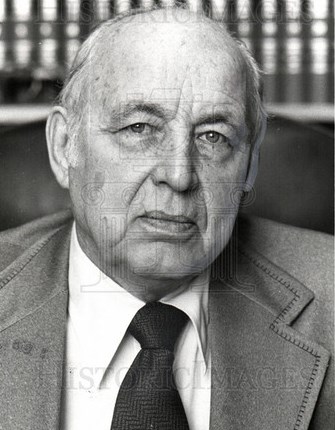
Judge Joseph Maher–1976 press photo
“What is disturbing is the fact that the jury had to reject the testimony of Dennis Van Fleteren, an eye witness who was also a Detroit Police Officer, and the partner of the deceased, to convict the Defendant. The jury had to also reject the testimony of Jay Smith, who was also an eye witness to the murder. Both Dennis Van Fleteren and Jay Smith testified that the fatal shot that killed the deceased came from the driver side of a white Mark IV. The jury had also to reject the testimony of Kim Divine, Gloria Ratachek, Donald DeMarc, and William Eichmann. The jury also had to totally disregard the testimony of the first alleged perpetrator Leslie Nathanial. Mr. Nathanial testified that he was driving down Harper with his lights out on the night of the murder. The white Mark IV that was driven by Leslie Nathanial, it should be noted was destroyed in the Seventh Precinct impound lot. (Judge Thomas noted earlier in her statement of facts that Nathanial, arrested three hours after the killing, was released after giving a statement to then Sgt. Gil Hill.)
- “The high hurdles that the jury overcame to convict is clear evidence that the jury was swayed by the Judge’s instruction . . . .It is hard to fathom that a jury would summarily dismiss the testimony of a police officer who was also the partner of the deceased in favor of three juveniles. I also have some questions as to how four juveniles in two cars could be missed by everyone on the scene of the crime. It is the opinion of this Court that this above instruction by Judge Maher had a devastating effect on the jury.”
-
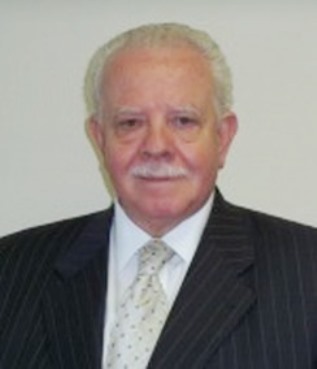
Judge Edward Thomas in 2005 after retirement.
Lewis’ “conviction should have been deemed vacated on September 22, 1980.” A “Pearson” evidentiary hearing was ordered held by the Court of Appeals on Aug. 22, 1980 after a motion for “a Delayed New Trial” made by Lewis’ then court-appointed attorney Rose Mary Robinson was denied by Recorders’ Court Judge Edward Thomas. The hearing was sought to include testimony from witnesses that had been excluded from Lewis’ second trial. Judge Thomas said, “In Pearson, the Michigan Supreme Court held, “Should the prosecutor fail to seek a post remand hearing within 30 days the conviction shall be deemed vacated and the prosecutor may proceed with a new trial.” The “Pearson” hearing was not held until January, 1981.
- “. . . .the removal of Rose Mary Robinson by Judge Edward M. Thomas (in October, 1980) was arbitrary and unjustified.” Judge Thomas agreed with Lewis’ legal citations from the Michigan Court of Appeals “that the unjustified removal of a Defendant’s appointed counsel during a critical stage in the proceedings violates the Defendant’s Sixth Amendment right to counsel.” Judge Edward Thomas replaced Robinson with Attorney Gerald Evelyn, who argued that he had not been given enough time to consult with his client to prepare for the hearing.
At the conclusion of her opinion, Thomas said, “It is the sincere hope of this Court that the Defendant will appeal this order to Michigan Court of Appeals, and further that the Michigan Court of Appeals will render an opinion in this matter that is consistent with justice.”
Read entire opinion at
http://voiceofdetroit.net/wp-content/uploads/DThomasOpinion.pdf
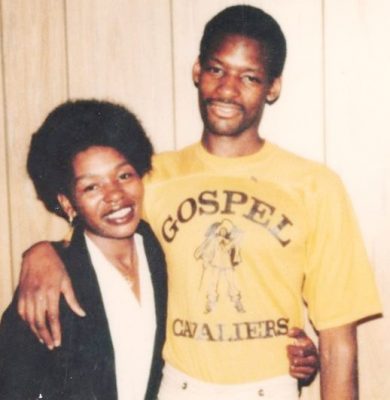
Rosie Lewis with her son Charles Lewis after his 1977 incarceration.
In interviews with VOD, Lewis and his mother fleshed out other key elements of what appears to be a deliberate, heinous miscarriage of justice aimed at covering up the true perpetrator(s) of Sypitkowski’s murder, which is shaping up more and more to look like a mob hit.
Lewis told VOD that there were actually THREE trials in his murder case. He said a jury was seated for a second trial in front of a judge other than Maher weeks after the first trial ended, but that Maher intervened, insisting that the case be re-assigned to him. The final trial in November resulted in his conviction after Maher told the jury, “Now you have heard evidence tending to show that the Defendant, Charles Lewis was GUILTY of another shooting in the course of an armed robbery for which he is now on trial here.”
His mother, an articulate, passionate woman who was associated with Chokwe Lumumba and others in the heyday of Detroit activism, told VOD she witnessed a shocking event during Lewis’ first trial. Charles, who Mrs. Lewis calls by his middle name “Lamont,” was the first of five children, including two sisters and two brothers.
At the time of his trial, his siblings were still children. Mrs. Lewis said she brought them to court because she could not afford day care and wanted them to support their brother as well. She said she brought food from home including apples and oranges.
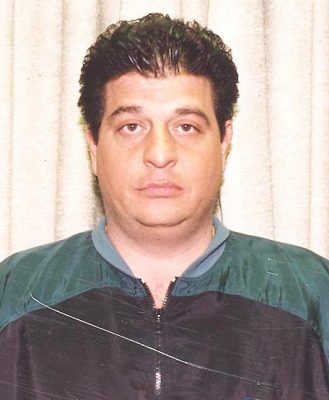
Lewis’ prosecuting attorney Robert Morgan represented Detroit mobsters including Paul Corrado, shown here.
“One of my kids dropped a bag of food in the courtroom during a break,” she told VOD. “I had to go in and get down on my hands and knees on the floor to pick it all up because I could not afford to buy any more. Then Judge Maher, the prosecutor [Robert Morgan] and the attorney for my son [Arthur Arduin] came in discussing the case, thinking no one else was there. Maher said, ‘The man [Sypitkowski] knew he was gonna get killed, that’s why he left out of the bar and that’s why he took his partner’s gun when he left.’ So they KNEW what really happened and weren’t going to do anything. They were all in on the frame-up of my son. I jumped up and confronted them about it. I called them names and screamed at them, ‘You know the truth—why are you lying on my son? You know he didn’t kill that man!’”
Mrs. Lewis said there was no one she could report the incident to, particularly because all those in power at the time were white.
Wayne County Prosecutor Robert Morgan, who handled Lewis’ case, became a top attorney for Detroit Mafia leaders. One was Paul Corrado, among of six indicted by a grand jury and tried in federal court in Detroit in 1998, according to numerous media reports and listings on the federal website.
“A grand jury indictment charges all of them in a 30-year conspiracy of extortion, loan-sharking, illegal gambling, obstruction of justice, and attempts to gain hidden control over Nevada casinos,” reported the Detroit Free Press on March 24, 1998.
The Las Vegas Sun said, “Robert Morgan, the attorney for alleged mafia member Paul Corrado, 39, of Macomb County’s Clinton Township, tried to downplay the hundreds of hours of taped conversations between his client and co-defendant Nove Tocco, 50, also of Clinton Township.
“Morgan, who called his client a “nitwit” and low-level bookie, said the tapes are full of obscenities, racial slurs and talk about criminal activity. But he said it was just talk, not linked to any action.
“They don’t shoot anyone,” he said. “Most of their shots are with their mouths. There are no bullet-ridden bodies. No one is ever shot at.”
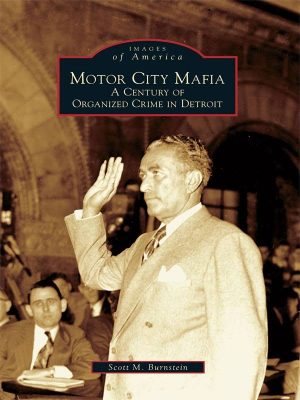
Book by Detroit mob expert Scott Burnstein.
The family of Gerald Sypitkowski would likely not agree with that assessment. Rosie Lewis earlier told VOD that Leslie Nathanial worked at Chrysler Jefferson Assembly, where she also worked. She said word in the plant was that he was a bookie. At the time, according to the book “Motor City Mafia: A Century of Organized Crime in Detroit,” by Scott M. Burnstein, the mob was heavily involved in bookmaking and extortion of store owners in certain areas.
VOD was able to locate and call one of the juvenile witnesses, Mark Alonzo Kennedy. He was reluctant to talk, but he did say, “Sure the police put pressure on us. It was the murder of a cop. We were 15, 16 years old; they threatened us with being charged too.”
Asked about what happened the night of July 31, 1976, he said he had tried to “black” it out of his mind and doesn’t remember much. VOD reminded him that Charles Lewis CAN’T block it out of his mind.
“I’m 57 years old now and that was 41 years ago,” Kennedy said. “We were driving down Harper going somewhere I don’t remember exactly. I HEARD gunfire, but I didn’t see where it came from. It was impossible to see who the shooter was because I was in the second vehicle and Charles was in the first vehicle.”
Regarding the police interrogation, he said, “One of the Boy Scouts said Charles’ name and other names.” Though prompted, he did not explain what he meant by the term “Boy Scouts.” Asked about the trial, he said he had company and hung up.
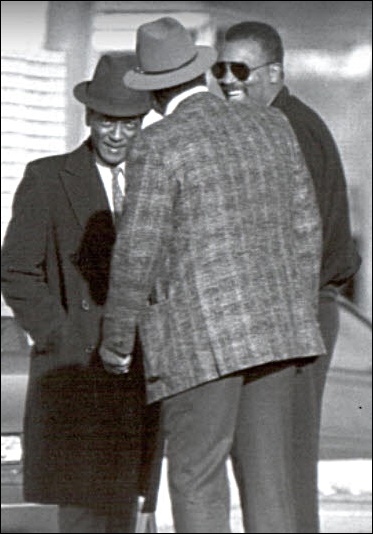
Gil Hill is seen in FBI surveillance photo conferring with known drug dealer Willie Volsan and Sgt. James Harris.
No one who witnessed the murder other than the juveniles testified that they saw two cars with four Black teens in them on Harper during the event.
On Jan. 17, VOD reviewed a cardboard box containing the transcripts of Lewis’ preliminary exam and his second trial, plus several thick documents including a partial transcript of his first trial, held apart, along with various lists of documents, and the original contents of Judge Lillard’s court record.
There was no Detroit Police Department file, no felony information record or investigator’s report authored by the DPD, normally included in a criminal case file. There were no witness statements from the three juveniles who testified against Lewis, which then Sgt. Gil Hill said during Lewis’ second trial were taken Aug. 1 and Aug. 6, 1976, or any videotapes of the statements. There were none from any of the eyewitnesses who said they saw gunfire from a Lincoln Mark IV kill Sypitkowski.
According to the transcript, Hill said during Lewis’ trial that usually all juveniles are processed through juvenile court, not the Homicide Division of the DPD. But he said he headed a “Special Assignment Squad” which was used in cases involving shootings or killings of police officers. He said he designated Sgt. Marvin Johnson to be the “officer-in-charge” of the case, but on the day of the trial, he testified that Johnson was not available because he was in a hospital intensive care unit suffering from cardiac problems. So Hill testified in his stead. Hill was the officer who discounted reports regarding the white Lincoln Mark IV in a story published by the Detroit Free Press Aug. 1, 1976.
As VOD pointed out in its earlier story “Dirty Dealings,” drug dealer and police snitch “White Boy Rick” Wershe said he told the FBI about Hill’s involvement in numerous homicide cover-ups, and a hitman Nate Boone Craft said as part of a documentary on Wershe’s life that Gil Hill tried to hire him to kill Wershe. The FBI investigated Hill over a period of time, but never charged him. Story at http://voiceofdetroit.net/2016/12/23/dirty-dealings-gil-hills-role-in-white-boy-rick-case-charles-lewis-and-eddie-joe-lloyd-frame-ups/
During its examination of the “re-constituted” file, VOD did not locate 34 documents listed on a page titled “Charles Lewis–Index of Court Documents,” except for his preliminary exam transcript. Also not present were documents listed on other pages scattered throughout the file.
(See http://voiceofdetroit.net/wp-content/uploads/ListsMissingDocuments.pdf.)
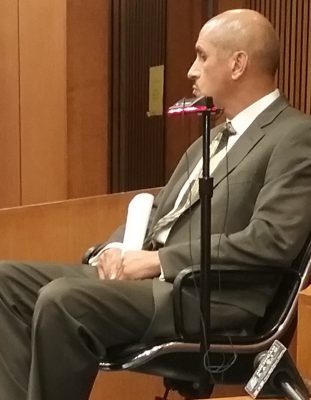
Wayne County Deputy Court Clerk David Baxter testifies at Charles Lewis hearing Oct. 28, 2016 that his case file had gone completely missing.
Most of the documents in the box, consisting of trial transcripts of Lewis’ second trial, were stamped on top “filed May 4, 2016,” although alleged dates of original filing existed in the body of the documents. It was unclear how these documents were obtained.
Among documents on top of the file was an email sent by Deputy Court Clerk David Baxter to Patricia Ways Nov. 7, 2016, titled “Report for Charles Lewis 76-5890,” listing documents his office had in its possession at that point.
One Cheryl Jordan responded to Baxter, asking him “Comparing this to the ROA [Register of Actions] are any transcripts still missing?” Baxter responded, “There is no Register of Actions for this case. The only information in Odyssey is data that was converted from AS400. The first entry in the computer is from April of 2000.”
(See email at http://voiceofdetroit.net/wp-content/uploads/BaxterEmail.pdf.)
Michigan state law regarding contents of court files considers the presence of a valid Register of Actions, listing all documents placed in the case file, to be of primary importance.
Whether Judge Lillard will certify the contents of the “re-constituted” case file as she indicated in her order remains to be seen. Either way, there is enough evidence out there to indicate that Charles Lewis is innocent of the murder of Gerald A. Sypitkowski. It is certainly enough to have convinced Judge Deborah Thomas, a prominent community leader who conducted a determined battle to get more Detroit residents, especially Blacks, on Wayne County Circuit Court juries. Judge Thomas has also twice run for the State Supreme Court as the Democratic Party nominee.
Will Judge Lillard go ahead with the re-sentencing of an innocent man, either to life without parole again as the prosecution asks, or to 40-60 years, as Lewis’ court-appointed attorney Valerie Newman wants?
Or will she “render an opinion in this matter that is consistent with justice,” as Judge Deborah Thomas wanted?
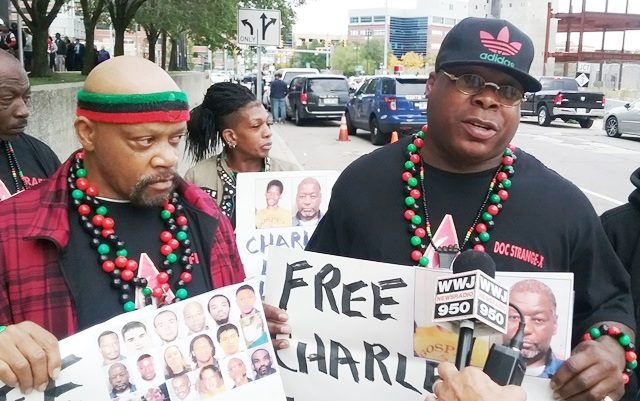
Charles Lewis supporter Doc X, with others, talks to media outside courtroom Oct. 11, 2016. Photo: Cornell Squires
Related stories:
#FREECHARLESLEWISNOW, #FREEMICHIGANJUVENILELIFERSNOW, #ENDMASSINCARCERATION, #ENDSCHOOLTOPRISONPIPELINE




